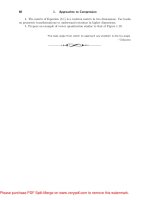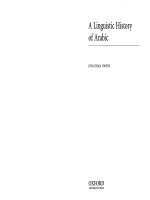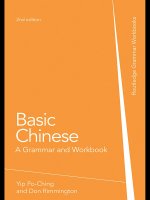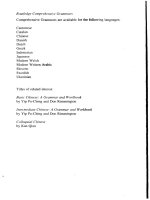chinese a linguistic introduction
Bạn đang xem bản rút gọn của tài liệu. Xem và tải ngay bản đầy đủ của tài liệu tại đây (2.29 MB, 250 trang )
This page intentionally left blank
Chinese: A Linguistic Introduction
Chinese is spoken by more people than any other language in the world, and has
a rich social, cultural and historical background. This is a comprehensive guide
to the linguistic structure of Chinese, providing an accessible introduction to
each of the key areas. It describes the fundamentals of its writing system,
its pronunciation and tonal sound system, its morphology (how words are
structured), and its syntax (how sentences are formed) – as well as its historical
development, and the diverse ways in which it interacts with other languages.
Setting the discussion of all aspects of Chinese firmly within the context
of the language in use, Chinese: A Linguistic Introduction will be of great
benefit to learners wishing to extend their knowledge and competence in the
language, and their teachers. It will also be a useful starting point for students
of linguistics beginning work on the structure of this major world language.
Chaofen Sun is Associate Professor of Chinese in the Department of
Asian Languages, Stanford University, and Adjunct Professor at East China
Normal University, Shanghai. He is editor of Chinese Historical Syntax and
Morphology (1999), Proceedings of the North American Conference of Chi-
nese Linguistics (1999), and Studies on the History of Chinese Syntax (1997);
and author of Word Order Change and Grammaticalization in the History of
Chinese (1996).
Linguistic Introductions available from Cambridge University Press
Romani: A Linguistic Introduction Yaron Matras
Yiddish: A Linguistic Introduction Neil G. Jacobs
Portuguese: A Linguistic Introduction Milton Azevedo
Ancient Egyptian: A Linguistic Introduction Antonio Loprieno
Chinese: A Linguistic Introduction Chao Fen Sun
Russian: A Linguistic Introduction Paul Cubberley
Introducci´on a la ling¨uistica hisp´anica Jose Ignacio Hualde, Antxon Olarrea,
Anna Mar
´
ıa Escobar
French: A Linguistic Introduction Zsuzsanna Fagyal, Douglas Kibbee and
Fred Jenkins
An Introduction to Language and Linguisties edited by Ralph Fasold and
Jeffrey Connor-Linton
Derivations in Minimalism Samuel David Epstein and T. Daniel Seely
Chinese: A Linguistic
Introduction
Chaofen Sun
Cambridge, New York, Melbourne, Madrid, Cape Town, Singapore, São Paulo
Cambridge University Press
The Edinburgh Building, Cambridge ,UK
First published in print format
- ----
- ----
- ----
© Chaofen Sun 2006
2006
Information on this title: www.cambrid
g
e.or
g
/9780521823807
This publication is in copyright. Subject to statutory exception and to the provision of
relevant collective licensing agreements, no reproduction of any part may take place
without the written permission of Cambridge University Press.
- ---
- ---
- ---
Cambridge University Press has no responsibility for the persistence or accuracy of s
for external or third-party internet websites referred to in this publication, and does not
guarantee that any content on such websites is, or will remain, accurate or appropriate.
Published in the United States of America by Cambridge University Press, New York
www.cambridge.org
hardback
p
a
p
erback
p
a
p
erback
eBook (EBL)
eBook (EBL)
hardback
Contents
List of maps viii
List of tables ix
List of figures x
Preface xi
Major chronological divisions of Chinese history xiii
Major periods of the Chinese language xiv
Introduction 1
1 Historical background of the language 13
1.1 Prehistoric time 13
1.2 Oracle-bone and bronze scripts 14
1.3 Old Chinese (771 BCE to 220 CE) 15
1.4 Middle Chinese (220 CE to 960) 17
1.5 Early modern Chinese (960 to 1900) 18
1.6 Modern Chinese (1900 to present) 20
1.7 Modern Chinese grammar and its lexicon 23
1.8 Simplification of Chinese script 26
1.9 Formation of Chinese dialects 28
1.9.1 Northern Chinese (Mandarin) 29
1.9.2 Southern dialects 30
2 Phonetics of standard Chinese 34
2.1 Initials 35
2.2 Finals 36
2.2.1 Medials (on-glide) 37
2.2.2 Main vowels 37
2.2.3 Syllabic terminals (off-glide) 38
2.3 Rhotacization 38
2.4 Tones 39
2.5 Tone-sandhi 40
v
vi Contents
3 Chinese morphology 1 45
3.1 Compounding 49
3.2 Derivation-like affixes 56
3.2.1 Prefixes 56
3.2.2 Suffixes 58
3.2.3 Potential markers -de-
and -bu- as infixes 60
3.3 Inflection-like affixes 64
3.3.1 Perfective marker -le
64
3.3.2 Experiential marker -guo
68
3.3.3 Imperfective marker -zhe
70
3.4 Summary 73
4 Chinese morphology 2 75
4.1 Clitics 75
4.1.1 Sentence-final particles 75
4.1.2 Locative particles 81
4.2 Reduplication 88
4.2.1 Classifiers 88
4.2.2 Informal kinship terms 89
4.2.3 Adjectives 90
4.2.4 Verbs 92
4.3 Beyond morphology 95
4.4 Summary 99
5 Chinese writing 101
5.1 Chinese characters 101
5.2 The history of Chinese script 103
5.3 The strokes of Chinese writing 107
5.4 Simplified standard script 110
6 Chinese language and culture 115
6.1 Cultural beliefs and Chinese expressions 116
6.1.1 Philosophical beliefs and Chinese expressions 116
6.1.2 Metaphors the Chinese live by 122
6.1.3 Politeness 126
6.2 Language contacts and borrowings 133
6.3 Neologisms and morpheme-syllable script 141
6.4 Summary 145
7 Chinese syntax 1 147
7.1 Linear order, lexical categories, subcategorization, and
semantic roles 148
Contents vii
7.2 Other lexical categories 153
7.3 Constituency 158
7.4 Selectional restrictions 164
7.5 Chinese pronouns and demonstratives 166
7.6 Negation 170
7.7 Sentence types 172
7.7.1 Interrogative 172
7.7.2 Imperative 181
8 Chinese syntax 2 184
8.1 Nominalization 186
8.2 Relative clauses 188
8.3 Cleft sentences 189
8.4 Adverbials 191
8.4.1 The word order and semantics of some common
Chinese adverbs 191
8.4.2 Adverbial clauses 197
8.5 Serial-verb constructions 200
8.5.1 Three types of serial-verb constructions 200
8.5.2 Causative construction 205
8.6 Prepositions 206
8.6.1 Flexible prepositional phrases 206
8.6.2 The comparative, passive, and b
˘
a constructions 209
8.6.2.1 Comparative 209
8.6.2.2 Passive 211
8.6.2.3 The b
˘
a construction 212
8.7 Summary 218
Appendix 1 Phonetic symbols 220
Appendix 2 Capitalized abbreviations 223
References 225
Index 229
Maps
1 Languages spoken in China page 3
2 The Qin Dynasty (221–206 BCE) 16
3 The Han Dynasty (206 BCE–220 CE) 18
viii
Tables
1 Tonal variation in Chinese dialects page 7
2 Pronunciation of some Chinese cognates in different
dialects 7
3 A comparison of the languages used in the speech
communities in Hong Kong, Shanghai and Guangzhou 10
1.1 Sino-Tibetan comparisons 14
1.2 Initials in p
˘
ut
¯
onghu
`
a 22
1.3 Finals in p
˘
ut
¯
onghu
`
a 22
2.1 The four basic tones in standard Chinese 39
5.1 Early development of Chinese script 104
6.1 Five categories under the five elements 125
6.2 Chinese terms for European words in three Chinese
communities 140
ix
Figures
2.1 Chinese initial consonants page 36
2.2 Chinese medials 37
2.3 Chinese main vowels 37
2.4 Chinese syllabic terminals 38
2.5 Chinese rhotacization 38
8.1 Phrase structure tree for example (8.2a) 185
8.2 Phrase structure tree for example (8.2b) 186
x
Preface
Over the past decade, with more and more students thinking of a China-related
career, interest in Chinese culture and China’s languages has grown rapidly.
In the meantime, at Stanford University where I teach Chinese linguistics, the
Chinese as a foreign language program has become the second-largest one
in terms of the number of students enrolled in different levels of instruction.
In writing this book, I hope to systematically introduce English-speaking
students to some basic linguistic knowledge, in addition to different socio-
cultural aspects of the Chinese languages to meet their diverse interests. I first
recognized the need for such an elementary book when I was preparing to
teach a new course on Chinese language, culture and society in 1998 and could
not find any published work in English specifically dealing with the topic.
It so happened that in the summer of 2001 Ms. Kate Brett of Cambridge
University Press visited me and, upon hearing of my search for such a book,
encouraged me to write one myself. The following year, I submitted a book
proposal and was very glad that Cambridge University Press quickly decided
to move forward with it.
In the course of writing the manuscript, I have received generous support
from my colleagues and friends. In particular I want to take this opportunity
to express my gratitude to the Dean’s office of the School of Humanities and
Sciences at Stanford University and Stanford Humanities Center for provid-
ing me with a Stanford Humanities Fellowship that has given me a year’s
time to write up this manuscript. I also want to thank the Stanford Center for
East Asian Studies that provided me with an undergraduate research assis-
tantship in the 2004 summer allowing me to work with Andrea Snavely, who
has corrected my English errors and offered many valuable suggestions to
make the manuscript more readable to a general audience. In addition, I want
to acknowledge my gratitude toward the anonymous Cambridge University
Press reviewer for valuable comments and suggestions making me clarify
my thinking and correcting many mistakes. I am also grateful to Cambridge
xi
xii Preface
University Press editor, Ms. Helen Barton, for her patience. Finally, I must
mention my many students over the years as they are really the reason for me
to write this book. In the course of this effort, my knowledge of the field was
greatly extended either through our discussion and debate in and out of class
or through the research I did on various topics of our common interest.
Of course, all the errors in this book are completely mine.
Major chronological divisions of
Chinese history
Xia dynasty – twenty-first to sixteenth centuries BCE
Shang dynasty – sixteenth to eleventh centuries BCE
Western Zhou dynasty – eleventh century to 770 BCE
Spring and Autumn period – 770 to 403 BCE
Warring States period – 403 to 221 BCE
Qin dynasty – 221 to 207 BCE
Han dynasty – 206 BCE to 220 CE
Three Kingdoms period – 220 CE to 265
Jin dynasty – 265 to 420
Northern and Southern dynasty – 420 to 589
Sui dynasty – 589 to 618
Tang dynasty – 618 to 907
Five Dynasties period – 907 to 960
Northern Song dynasty – 960 to 1127
Southern Song dynasty – 1127 to 1279
Liao dynasty – 916 to 1126
Jin dynasty – 1115 to 1234
Yuan dynasty – 1279 to 1368
Ming dynasty – 1368 to 1644
Qing dynasty – 1644 to 1911
xiii
Major periods of the Chinese language
Oracle and Bronze inscriptions sixteenth century to 771 BCE
Old Chinese 771 BCE to 220 CE
Middle Chinese 220 CE to 960
Early Modern Chinese 960 to 1900
Modern Chinese 1900 to present
xiv
Introduction
The phonetic transcriptions used in this book for Mandarin data are the
officially adopted h
`
any
˘
up
¯
ıny
¯
ın spelling used in China. The data from vari-
ous Chinese dialects are transcribed in the International Phonetic Alphabet
adopted by the International Phonetic Association (see Appendix 1).
1 China and Chinese in the world
For centuries China stood as the most powerful country in Asia with a splendid
civilization, outpacing the rest of the world in many ways. With the longest
unbroken line of recorded history, its extant literature has lasted for more than
three millennia, with a legacy extending back to 1500 BCE and with many out-
standing Chinese scholars in science, philosophy, literature, and many other
fields that continue to influence the modern world. However, in the nineteenth
and early twentieth centuries, China was devastated by a series of foreign inva-
sions, famines, and internal turmoils that prevented it from keeping pace with
the rapid developments in science and technology and caused it to lag behind
the industrialized world in many aspects. It was not until 1979, when Chinese
leaders decided to reopen China’s doors to the outside world and to convert its
state-planned economy into a market-oriented one, that China’s national econ-
omy started to develop at one of the world’s fastest growth rates. After more
than twenty years of sustained development, China is now the fourth-largest
trading nation and has the second-largest foreign reserves in the world.
1
Its
major trading partners include the United States, Japan, Germany, France,
the United Kingdom and many other European Union members. In fact, it
has been claimed that, measured on a purchasing-power parity basis, China
currently stands as the second-largest economy in the world after the United
States.
2
As the world is becoming more and more integrated, contacts between
China and the rest of the world have also become common. During the last
1
2 Chinese: A Linguistic Introduction
ten years of the twentieth century, China actually sent more international
students than any other country in the world to study in the United States. In
recent years, many people, particularly overseas Chinese, have moved to live
and build up their careers in the People’s Republic of China.
The population in China alone accounts for about 1.3 billion,
3
approxi-
mately one-fifth of the total population of the human race. With such a high
percentage of the human race growing up speaking different varieties of the
language as their first language, Chinese is indisputably one of the most com-
monly used languages in the world.
Against such a background, interest in the Chinese language has grown
rapidly outside China. Over the last decade, many colleges in the United
States saw the number of students enrolled in their Chinese-language classes
double, or in some cases triple. It has been reported
4
that, accompanying
China’s becoming an official member of the World Trade Organization in
2003, the total number of non-Chinese students who were studying Chinese
outside the People’s Republic of China reached 25 million. In the same year,
there was a great shortage of qualified Chinese-language instructors in the
People’s Republic to teach some 50,000 foreign students who had traveled to
China to study Chinese.
2 China
China is a unitary multinational state which officially recognizes 56 eth-
nic groups including Han, Zhuang, Uygur, Hui, Yi, Tibetan, Miao, Manchu,
Mongol, Buyi, and Korean. Chinese, or zh
¯
onggu
´
or
´
en
, is used to refer
to all citizens the People’s Republic of China regardless of ethnic national-
ity. Apart from the Han majority, the non-Han Chinese, with a total of more
than 96.5 million people, constitute roughly 8% of the total population in
the People’s Republic. Small as the percentage may appear, they neverthe-
less inhabit nearly 60% of the land mass of the nation. Nearly all the ethnic
groups have spoken languages of their own, and twenty-three have written
languages of their own (Map 1 is a linguistic map of China). In the south are the
Tai-speaking Zhuang people; in southwest China reside the Tibeto-Burman
speakers like Tibetans, Yi, etc; in the northwest corner live the Turkic branch
Altaic speakers like Uygurs and Kazakhs; in the north are Altaic speakers like
Mongols, Koreans, etc. With a population larger than 15 million, Zhuang is,
next to Han, the largest ethnic group in China. However, there are eighteen
Introduction 3
Map 1
other ethnic groups with a population larger than a million, including Manchu,
Hui, Miao, Uygur, Tibetan, Mongolian, Korean and Kazakh. Another fifteen
ethnic groups have a population larger than 100,000. The rest are smaller
(Zhou 2003).
The territory of China currently occupies an area of about 9,600,000 square
kilometers in East Asia, a country that is geographically almost as big as the
United States or only 700,000 square kilometers smaller than the entirety
of Europe. After the 1911 Revolution when the Qing Empire fell after a
popular revolt led by Dr. Sun Yat-sen’s Nationalist Party, the new Republic
was then known as zh
¯
onghu
´
am
´
ınggu
´
o
“Republic of China.” Later,
4 Chinese: A Linguistic Introduction
in 1949, the Nationalists under the leadership of Generalissimo Chiang Kai-
shek, lost the civil war and control of most of China to the Chinese Communist
Party led by Mao Zedong, and the name of the country was changed into
zh
¯
onghu
´
ar
´
enm
´
ın g
`
ongh
´
egu
´
o
“the People’s Republic of China.”
Nowadays, the Republic of China has jurisdiction over the island of Taiwan
where the Nationalist government continued to rule after its defeat in the
mainland in 1949. However, in spite of the differences in official names, the
Chinese people in modern times most commonly identify China in Chinese
with the shortened form zh
¯
onggu
´
o
, that is composed of the first and last
syllables of the two official names of modern China.
In Chinese history, the country was most commonly referred to in Chinese
by the name of its ruling empire such as d
`
aq
¯
ınggu
´
o
“the Qing Empire”
(1644–1911 CE). Even the English name of the country, i.e., China, may be
phonetically related to the sounds of the name of the powerful Qin dynasty
(221–207 BCE), which defeated various warring states and established the
first Chinese empire with a highly centralized government. However, after
the 1911 Revolution, the country was commonly referred to as zh
¯
onggu
´
o.
Furthermore, the Chinese people have used zh
¯
onggu
´
o
to denote the area
where the natives accept and carry on the Chinese civilization for a very
long time, although sinologists sometimes translate zh
¯
onggu
´
o into English
literally as Middle Kingdom or sometimes Central States. In isolation, the
two syllables, zh
¯
ong
and gu
´
o , that make up the short name actually carry
the meanings “middle” or “central” for zh
¯
ong and “country” or “state” for gu
´
o
separately. But the notion of Central States implies multiple entities, whereas
Middle Kingdom refers to one country. As early as the Chunqiu period (770–
476 BCE),
5
zh
¯
ong-gu
´
o, refers to a geographical area with many warring states
and, therefore, Central States is an appropriate translation for the land at that
time. For example, in (1) zh
¯
onggu
´
o was already in use referring to an area
contrasting with y
´
ıd
´
ı
“foreign countries” in a document written over two
millennia ago.
(1)
Hu´an g¯ong ji`uzh¯onggu´o´er rˇang y´ı-d´ı
Name duke save central-states and resist foreign-foreign
“Duke Huan saved the central states and resisted the foreign
countries.”
Introduction 5
Therefore, at that time, zh
¯
onggu
´
o was already used as a term to distinguish
the states that embraced Chinese civilization from those that did not. However,
after all the warring states were unified by the Qin dynasty (221–207 BCE)
under one central government, the term zh
¯
onggu
´
o, from its former sense, a
central area occupied by a number of states, naturally developed into a noun
for the unified country. This happened as early as the Han dynasty (206 BCE–
220 CE). In example (2), zh
¯
onggu
´
o clearly refers to the entire Han empire.
Therefore, it makes sense to translate it as “Middle Kingdom.”
(2)
ti¯an-xi`am´ıng sh¯an b¯a´er s¯an z`ai m´an-y´ı
sky-down noted mountain eight and three in foreign-foreign
w˘uz`ai zh¯ong-gu´o
five in central-state
“There are eight famous mountains in the world. Three are in
foreign countries, and five in the Middle Kingdom.”
From these examples we can see that the Chinese name for China,
zh
¯
onggu
´
o, originally refers to a number of states situated roughly along the
Yellow River in North China that defines the limits of Chinese civilization and
later becomes a noun designating the unified empire. In modern times, when
serving as a short name for China, the meanings of “central,” or “middle” in
this lexical item are completely lost.
6
3 Chinese
Chinese, as a language name in English, refers to the Sinitic subgroup of
Sino-Tibetan languages in Asia. But it can be translated into various Chinese
nouns for the language encompassing many different ideas depending on the
context. First of all, Chinese can be translated as zh
¯
ongw
´
en
generally
referring to the language. Zh
¯
ongw
´
en
is also the right term to use for
the academic discipline in studying Chinese language and literature, such as
zh
¯
ongw
´
enx
`
ı
for the Chinese department in a university setting. Second,
the term h
`
any
˘
u
“Han language” is used in the context contrasting the
languages spoken by the Han nationality that makes up 92% of the 1.3 billion
Chinese citizens of the People’s Republic with all of the non-Han languages
6 Chinese: A Linguistic Introduction
spoken in China and the rest of the world. Therefore, foreign students who are
now learning Chinese are said to be learning h
`
any
˘
u
. Third, as h
`
any
˘
u is
a general term for the languages, many of which are mutually unintelligible
among speakers of different varieties of Han language, it by default refers
to the standard dialect of the country that is known as p
˘
ut
¯
onghu
`
a
lit-
erally meaning “common language” in the People’s Republic. P
˘
ut
¯
onghu
`
a
is a constructed norm based upon the language, a variety of Northern
Chinese, spoken in the capital city, Beijing. Moreover, Chinese corresponds
to a number of Chinese equivalents depending on the given speech commu-
nity. In Singapore, an important Chinese-speaking community, as well as in
the other Chinese communities in Southeast Asia, Chinese is known as hu
´
ay
˘
u
“Hua-language,” as Hu
´
a is another Chinese name for the Han-Chinese. In
Taiwan, for historical reasons, standard Chinese is known as gu
´
oy
˘
u
,
literally “national language.” Different as hu
´
ay
˘
u
and gu
´
oy
˘
u may
appear, the standard is practically the same as p
˘
ut
¯
onghu
`
a. Mandarin refer-
ring to Northern Chinese in English originated from the fact that the Mandarin
officials of the Qing Empire spoke to each other in that language. Fourth,
“Chinese” also refers to different Chinese dialects, or h
`
anf
¯
angy
´
an
,but
does not include any of the non-Han-Chinese languages spoken by ethnic
minorities in China.
An extraordinary phenomenon for the Han-Chinese is the lack of mutual
intelligibility among people within the same ethnic group. A Chinese person
from Beijing who has grown up speaking the most prestigious dialect of the
nation cannot speak or understand the local languages in the south, or the so-
called Southern Chinese dialects, such as those used in the streets of Shanghai
or Hong Kong. Traditionally, Han-Chinese is divided into seven major dialect
groups, Mandarin (or beifanghua Northern Chinese), Wu, Xiang, Gan, Kejia
(Hakka), Yue (Cantonese), and Min.
7
Among the Han-Chinese, Northern
Chinese speakers comprise 70% (840 million), Wu 8.5% (102 million), Yue
5.5% (66 million), Min 4.5% (54 million), Kejia 4% (48 million), Gan 2.5%
(30 million), and Xiang 5% (60 million).
8
In spite of sharing a large number
of cognates, or words of common origin, Chinese dialects vary most strik-
ingly in their sound systems. All Chinese dialects have tones with different
pitch contours for each syllable (for details see chapter 2). Table 1 shows
the tonal variations of different dialects as given in h
`
any
˘
uf
¯
angy
¯
ın z
`
ıhu
`
ı “A
list of words with dialectal pronunciations” (Chinese Department, Beijing
University 1989).
Introduction 7
Table 1 Tonal variation in Chinese dialects. 55, 35, 214, etc. are tonal
values. For a more detailed description please refer to section 2.4.
Dialect City Tones (with tonal values)
Mandarin Beijing four tones: 55, 35, 214, 51
Wu Suzhou seven tones: 44, 24, 52, 412, 31, 4, 23
Xiang Changsha six tones: 33, 13, 41, 55, 21, 24
Gan Nanchang seven tones: 42, 24, 213, 45, 21, 5, 21
Kejia Meixian six tones: 44, 11, 31, 52, 1, 5
Yue Guangzhou nine tones: 55, 21, 35, 23, 33, 22, 5, 22, 2
Min Xiamen seven tones: 55, 24, 51, 11, 33, 32, 5
Table 2 Pronunciation of some Chinese cognates in different dialects.
City “mouth” “gold” “male” “province”
Beijing kou jin nan sheng
Suzhou k’
y tin nø *sən/saŋ
Changsha kəutin lan sən
Nanchang k’i
εutin lan *sεn/saŋ
Meixian *k’εu/hεu kim nam *sεn/saŋ
Guangzhou hɐukɐm nam ʃaŋ
Xiamen *k’ɔ/k’au kim lam siŋ
* The first of the pair represents literary pronunciation, w
´
end
´
u, and the second colloquial
pronunciation, b
´
aid
´
u.
The examples in Table 2 show the diversified pronunciation of cognates
for mouth, gold, male, and province in different Chinese dialects (Chinese
Department, Beijing University 1989).
The seven major Chinese dialect groups are actually like many European
languages that are members of the Indo-European language group but are
mutually unintelligible. However, unlike Europeans, the inability to under-
stand each other’s speech has not made Chinese speakers feel any less Chinese,
regardless of the variety of language they grew up speaking. Norman (1988: 1)
observes that:
The explanation is to be found in the profound unity of Chinese culture that has been
transmitted in an unbroken line beginning from the third millennium BC and continuing
down to the present day. Even in periods of political disunity at various times in the
past, the ideal of a single, culturally unified Chinese empire has never been forgotten.
The Chinese language, especially in its written form, has always been one of the most
powerful symbols of this cultural unity.
8 Chinese: A Linguistic Introduction
Unlike European languages, the writings of which are alphabetical and bear
a direct relationship to the speech sounds in the given language, Chinese
writing adopts a logographic system with characters that are partially morpho-
syllabic (see Chapter 4).
9
Although Chinese speakers from different parts of
the country may not be able to carry out a meaningful conversation in their
own spoken language, they can easily communicate in writing, which creates
a common, solidifying, and profound cultural bond among all Chinese dialect
speakers.
This connection is made possible by the fact that the grammar of writ-
ten Chinese generally follows the grammar of standard Chinese p
˘
ut
¯
onghu
`
a
without incorporating into it too many regional dialectal features. All Han-
Chinese children, particularly those growing up in dialect-speaking areas,
must learn to write in this literary language in school. Fortunately, in spite of
some minor structural variations, the syntactic structures in p
˘
ut
¯
onghu
`
a and
the various dialects do not differ substantially, thus making learning less oner-
ous for dialect-speaking children. Their primary task in learning p
˘
ut
¯
onghu
`
a
is to a large extent simply to master the sound system of the national standard.
For example, other than the differences in speech sounds, the most conspicu-
ous difference between two sentences in p
˘
ut
¯
onghu
`
a and Cantonese, or a Yue
dialect, is perhaps the perfective marker (glossed as PFV in (3), le versus zo,
that may not share a common origin.
(3)
p
˘
ut
¯
onghu
`
a:
w˘om˘ai le y`ı-bˇen sh¯u
1st buy PFV a-CL book
“I have bought a book.”
Cantonese:
η o mai zo jat-pun Sy
I buy PFV a-CL book
“I have bought a book.”
Of course, these similarities do not mean that learning the grammar of
standard Chinese is completely effortless for dialect-speaking Chinese chil-
dren. Dialectal variations among the Chinese dialects go beyond speech
sounds and vocabularies and definitely reach sentence grammar. For exam-
ple, in (4) the adverb xi
¯
an “first” goes before the verb in p
˘
ut
¯
onghu
`
a but
Introduction 9
the adverb Sin with a similar function in Cantonese takes the sentence-final
position.
(4)
p
˘
ut
¯
onghu
`
a:
w˘oxi¯an q`u
I first go
“I go first.”
Cantonese:
η ohaη Sin
I go first
“I go first.”
It is highly possible for a Cantonese speaker to learn to say something with the
correct p
˘
ut
¯
onghu
`
a pronunciation, but with the Cantonese sentence grammar
like w
˘
oq
`
uxi
¯
an “I go first.” In this case, even though the sentence may sound
very odd to a Northern Chinese speaker, the chance for her/him to comprehend
the sentence is still good. However, in the school setting, the wrong word
order in syntax would still be considered incorrect and not tolerated by the
teachers. In most cases, children growing up in a Cantonese-speaking area
would be taught to avoid speaking p
˘
ut
¯
onghu
`
a and writing formally in this
kind of ungrammatical manner.
Standard Chinese, or p
˘
ut
¯
onghu
`
a, is generally considered to be the most
prestigious variety of the Chinese language all over the country, perhaps
only with the exception of Hong Kong, which is located in the Yue-speaking
area. For example, whereas in the city of Shanghai, which is located in the
Wu-speaking area, the language that is most commonly used in schools is
p
˘
ut
¯
onghu
`
a, it is not so in Hong Kong as its sovereignty was not returned
to the Chinese authorities until 1997. During the 150 years of colonial rule
under the United Kingdom, English was considered the primary language of
the colony even though the majority of the people living in the colony could
not speak this language. Compared to Hong Kong, Guangzhou (Canton),
another city located in the Yue-speaking area which was never placed under
British rule, has a profile in which English is hardly used at all in any sociolin-
guistic domain. It seems that even though p
˘
ut
¯
onghu
`
a is most prestigious in
the two Southern-dialect-speaking cities, Shanghai and Guangzhou, English
is still the language that enjoys the highest prestige in Hong Kong as English
still figures most importantly in legal, governmental, and educational sectors,









